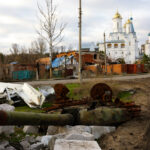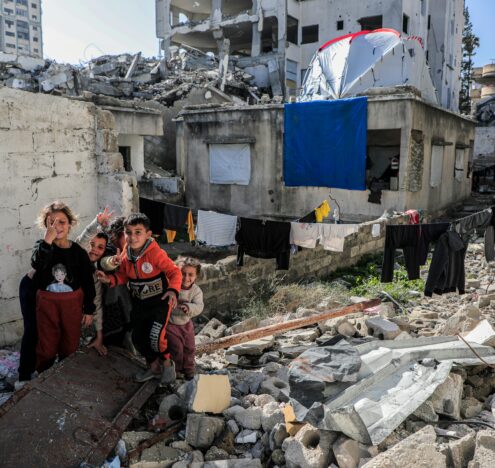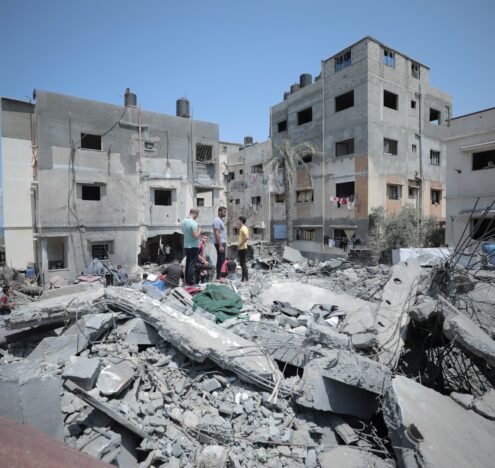I’ve quickly come to learn two things about the Washington, DC “nuke” policy community to which, as of about a year ago, I now belong: 1) it’s tiny; 2) it’s polarizing.
At every roundtable, public event, and happy hour, you’re likely to run into a few (dozen) familiar faces. It doesn’t take long to know who someone is and which “camp” they’re in. Looking for variety? Nuclear policy isn’t the place for you. At the end of the day, there are two options: You’re either firmly against nukes or willing to sell your soul to pay for more.
— Whoa. That escalated quickly! —
My thoughts exactly.
Freshly relocated to DC, I began my career somewhere left of center when it came to nuclear weapons. Inspired by Obama’s Prague Speech and the Nobel Prize-winning International Campaign to Abolish Nuclear Weapons (ICAN) – I, too, could envision a world without nuclear weapons.
However, despite being an optimist, I’m also a pragmatist. Upon meeting a recipient of the Nobel Peace Prize, I told her how much I respected the issue she represented but that I still firmly believed in nuclear deterrence. She sort of smiled and shrugged, replying with, “Just give it a little time and you’ll find your way to our side.”
Her side (the disarmament side) argues that the world is safer without nuclear weapons — therefore we should abolish them. The movement to ban nuclear weapons has ebbed and flowed since the United States first dropped bombs on Nagasaki and Hiroshima, Japan in World War II. It has experienced a recent resurgence spurred by Obama’s 2009 Prague Speech, ICAN’s acceptance of the Nobel Peace Prize in 2017, and the recent completion of the Treaty on the Prohibition of Nuclear Weapons (TPNW), which is now open for ratification.
When it comes to the disarmament camp, my first thought always goes straight to logistics. In theory: their argument might be true – the world could likely be a safer place without nuclear weapons. In practice, it is not that simple. Ponder this logistical nightmare for a moment: How might the world abolish every nuclear weapon in every country at exactly the same time?
We have held, sometimes decades-long, negotiations over everything from the amount of fissile material, numbers of centrifuges, percentages of enrichment, allowable facilities, peaceful uses, delivery systems, ways of destroying/disposing of material, to — most importantly – the means of verification for all of the above. Think Iraq, North Korea, Iran, Russia…
All I can imagine, and it doesn’t take much, is the prisoner’s dilemma of global zero: one country or actor decides they don’t want to play along. (I will give you nine guesses which country that will be.)
She sort of smiled and shrugged, replying with, “Just give it a little time and you’ll find your way to our side.”
Hypothetically, even if the international community were able to ensure the complete, verifiable, irreversible dismantlement of all nuclear weapons, how do you turn back the clock and dispose of the science? How do you erase the technological advancements that gave us nuclear weapons? What happens when one rogue country or actor challenges the new status quo?
If I ever make it past logistics (which I never do) – I can’t help but think of the valid concerns of camp number two: the proponents of nuclear deterrence. They contend that the possession of nuclear weapons by major global powers in the decades after the end of World War II has prevented these powers from going to war with one another, mostly out of knowledge that their adversary has a weapon that could destroy them.
Opponents of this theory essentially argue that every theory, like deterrence, only holds until disproven – in which case a nuclear state will have gone to war with another nuclear state and that may be the end of humankind (so, not great). But, the deterrence camp has time and history on its side. Since the first (and second) use of nuclear weapons — 73 years ago – no two countries in possession of nuclear weapons have gone to war with one another and none have ever used a nuclear weapon.
While both sides of the nuclear weapons debate bring with them valid concerns, we’ve forgotten that there may be room for a third camp. A camp rooted in the middle, seriously focused not on ideology but on finding practical ways to reduce the threat of nuclear war, through whatever means necessary in the current-day security climate. This group often finds its views drowned out in the contentious and bitter invective between the other two camps. Too hawkish to sit at the lunch table with the global zero camp, but too dovish to sit with deterrence advocates who denigrate arms control, there is a group that firmly believes that a pragmatic nuclear policy lies somewhere in the middle.
This group finds themselves happily envisioning a future world where a nuclear deterrent is increasingly unnecessary while simultaneously recognizing that our security climate is simply not yet there. In the interim, and likely for the foreseeable future, this group generally supports modernizing our nuclear triad to be flexible, reliable and advanced enough to match the security threats we face at home and by our allies abroad. At the same time, however, this group advocates on behalf of coupling a strong deterrence posture with diplomacy and a clear narrative regarding the important contributions this posture makes to security and stability.
This group also recognizes that newly proposed low-yield nuclear weapons may not lower a threshold of use but question their necessity. At a time when the United States can barely afford domestic services; is considering adding a 6th branch of the military; is pursuing emerging technologies; and is focusing on military readiness, this group questions whether adding additional capabilities to our nuclear arsenal is the right way ahead. It recognizes that replacing our nuclear triad with a dyad may be sufficient to deter nuclear attacks on the US homeland, but knows that eliminating a leg of the triad could disrupt strategic stability, alliance assurances, and practically (politically) is unlikely to pass in Congress. It recognizes a need to ground arms control in strategy, that verifiable transparency can temper even the toughest of adversarial relationships, and that strategic stability cannot be maintained without constant attention.
These are all topics, along with countless others, that are quietly discussed behind closed doors in hushed tones because there is no longer place for this talk in nonproliferation circles, and even hinting at a future world without deployed nuclear weapons will get you removed from the guest list at most hawkish tables.
So the question becomes: when did believing in pragmatic nuclear policy become so taboo? At what point did the nuclear community decide that if you weren’t reducing numbers, you were advocating for more and that if you were questioning modernization budgets that you clearly support the ban treaty?
We have lost civilized dialogue in the nuclear community on nuclear weapons. Until we get it back, the opposing camps will continue to advocate for ill-advised policies that fail to address the other sides’ valid concerns, and those in the middle won’t join the conversation for fear of retribution.
So when you’re done yelling over each other, let us know. We will be patiently waiting to set up our tent at campsite #3.




















